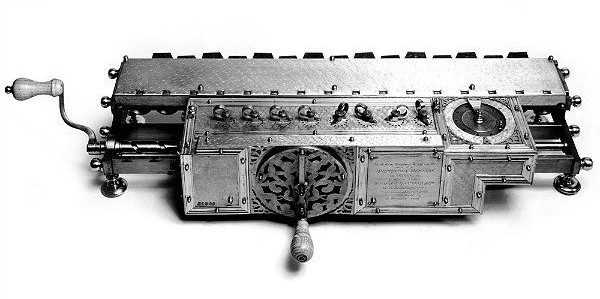


1726: Jonathan Swift, poet, and cleric, published Gulliver’s Travels, which includes this description of the Engine (a fictional device described in the novel). It is the earliest recorded reference to a system that matches a modern computer in any form. The Engine was a device that generated permutations of word sets. Permutations are arrangements of members into different sequences or linear orders or a readjustment of the set’s elements if it has already been ordered. The word “permutation” also refers to the act or process of changing the linear order of an ordered set. The machine is a parody of Ars Magna, one of the inspirations of Gottfried Leibniz’s mechanism.(1,2)


Gottfried Wilhelm Leibniz (1646–1716): recognized as the last “universal genius,” he was a great thinker of the seventeenth and eighteenth centuries. He made profound and meaningful contributions to metaphysics, epistemology, logic, philosophy of religion, mathematics, physics, geology, jurisprudence, and history. Leibniz developed the concepts of differential and integral calculus as his most notable accomplishment. In the world of mechanical calculators, he became one of the most influential inventors. This scientist was the first to define a pinwheel calculator in 1685 and invented “the Leibniz wheel,” used in the first digital mechanical calculator called the arithmometer while modifying Pascal’s calculator to provide automatic multiplication operation and division. Gottfried then improved the binary number system, which is the basis for virtually all digital (electronic, solid-state, discrete logic) machines, including the Von Neumann machine. The latter became the mainstream design model, or “computer architecture,” in the second half of the twentieth century and into the twenty-first.(3)

The Staffelwalze, or Stepped Reckoner, is a digital calculating machine designed by Gottfried Wilhelm Leibniz in 1672 and installed about 1700. It is on display in Dresden’s Technische Sammlungen museum. The first known calculator could perform all four arithmetic operations; addition, subtraction, multiplication, and division. It measured 67 cm (26 inches) long. Only two exemplars were made, and a contemporary replica remains in the National Library of Lower Saxony in Hannover.(3)
1750 : Julien Offray de La Mettrie (French physician and philosopher) published L’Homme Machine, which argued that human thought is strictly mechanical. In this work, de La Mettrie extends Descartes’ argument that animals are mere automatons, or machines, to human beings. He denies the existence of the soul as a substance separate from matter.(4)

1769: Wolfgang von Kempelen’s chess-playing automaton, The Turk, was designed and toured in 1769. It was later shown to be a hoax involving a human chess player. While von Kempelen had a long and fruitful career as a civil servant, he is best known for building The Turk, a chess-playing automaton proposed to Maria Theresa of Austria in 1769. The machine consisted of a life-sized human head and torso model, dressed in Turkish robes and a turban, seated behind a large cabinet with a chessboard on top. The computer seemed capable of playing a decisive chess game against a human opponent but was merely an elaborate mechanical automation simulation.(5)

The machine embedded a human chess master concealed inside a cabinet that puppeteered the Turk from below using a series of levers. With a skilled operator, the Turk won most of the games played during its demonstrations around Europe and the Americas for nearly 84 years, playing and defeating many challengers, including statesmen such as Napoleon Bonaparte and Benjamin Franklin.(5)
References